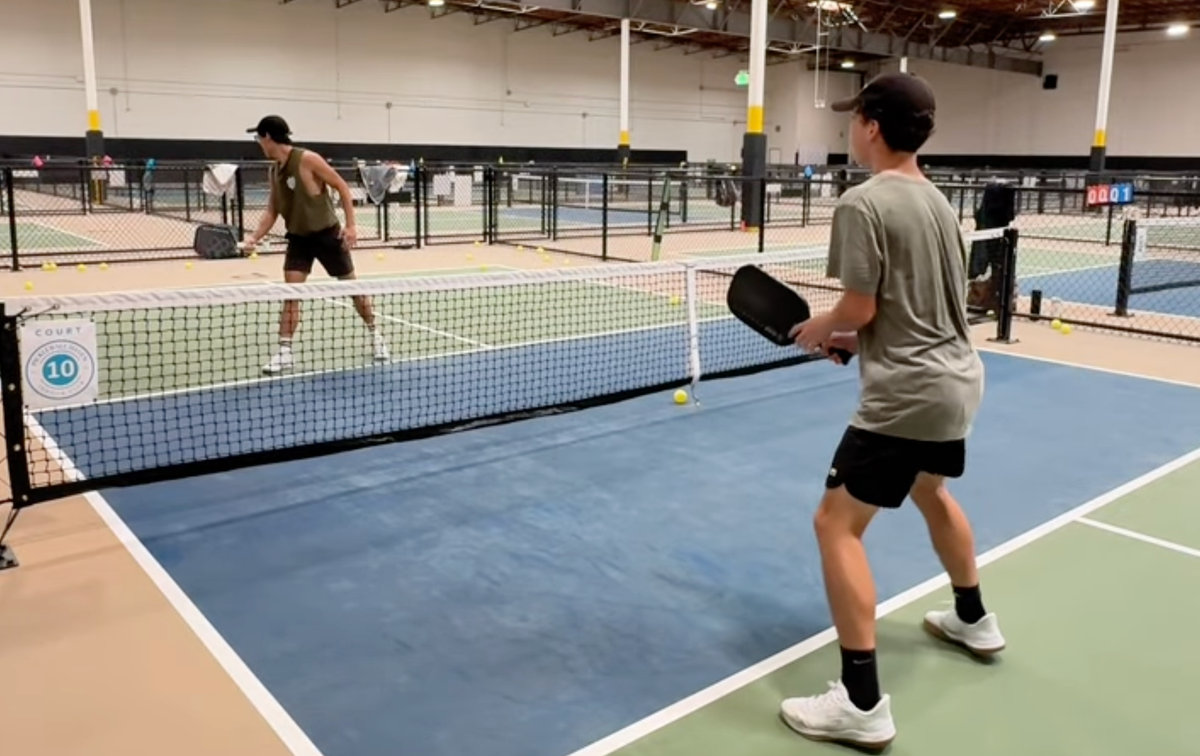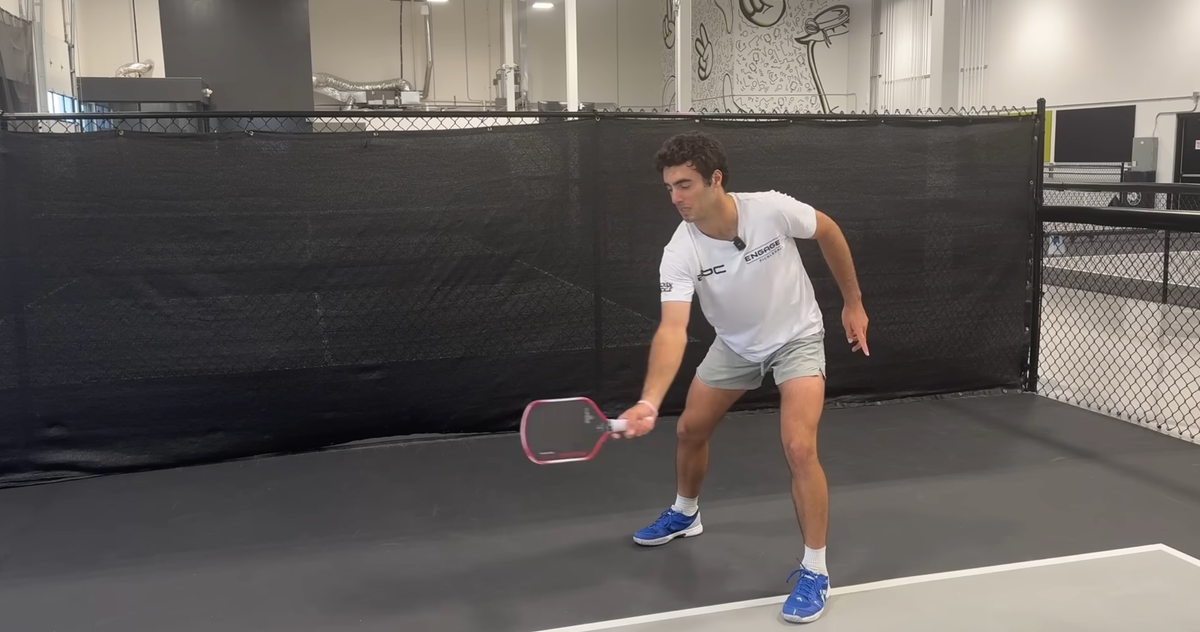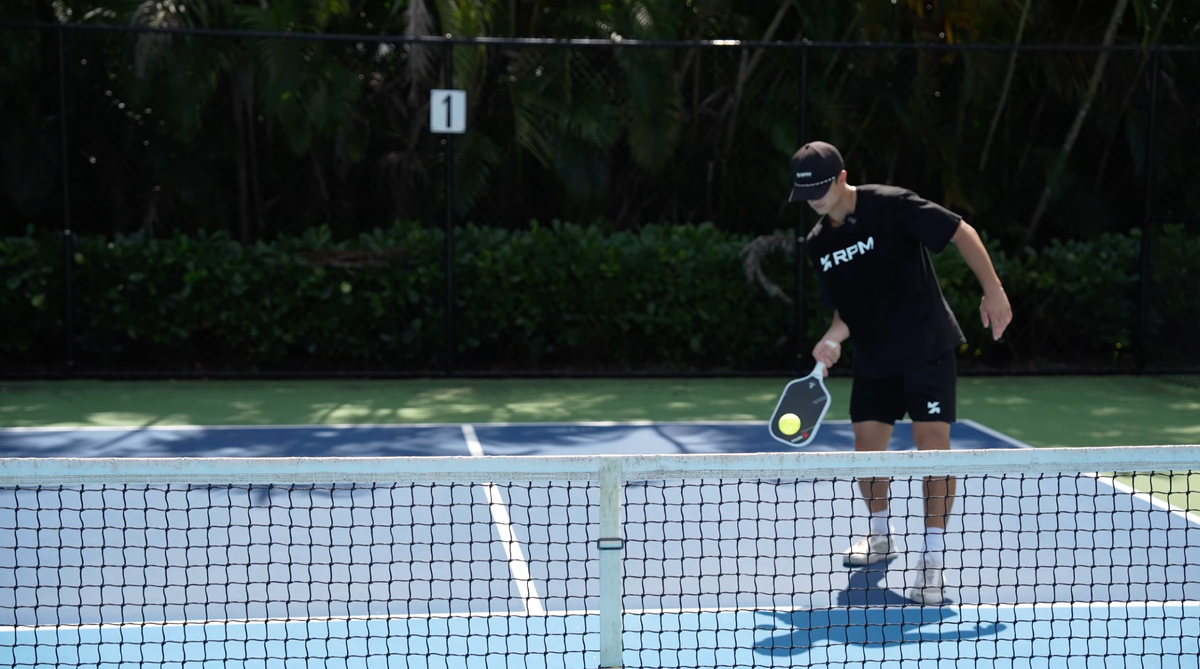As an active player in both sports, I’ve got some opinions to share from my experience. Let’s compare these two classic court types head-to-head – Pickleball Court vs Tennis Court!
Pickleball Court vs Tennis Court in a Nutshell
So what makes these courts different? Pickleball courts crush it with small dimensions, low nets, and non-volley zone. Tennis courts swing big with more space and higher nets.
 Pickleball Court vs Tennis Court
Pickleball Court vs Tennis CourtOverview of Pickleball and Tennis Courts
Pickleball Courts
I have to admit, I’m partial to pickleball courts. Here’s why they get my vote:
- Small and Social: At just 20×44 feet, pickleball courts provide an intimate, social vibe. You can chat with other players and spectators during the game!
- Accessible for All: The compact size and simplified rules make pickleball courts welcoming to players of all ages and abilities.
- Casual Play: With their low 34″ nets and casual community culture, pickleball courts encourage laidback recreational play rather than intense competition.
- Consistent Surface: Most pickleball courts are asphalt or concrete, allowing for nice consistent ball bounce.
The Not-So-Good
- Limited Space: The small dimensions don’t allow for high-speed play or full tennis conversion.
- Fewer Surfaces: Unlike tennis, surface options are very limited, usually asphalt or concrete.
Tennis Courts
While pickleball has my heart, I can’t deny tennis courts have their perks too:
- Competition-Ready: At 120×60 feet with higher nets, tennis courts are designed for serious competitive athletics.
- Surface Variety: From hard courts to clay to grass, tennis courts come in different surfaces to suit your play style.
- Doubles Friendly: With designated doubles alleys, tennis courts easily accommodate both singles and doubles matches.
The Not-So-Good
- Intimidating for Beginners: Large courts and intense competitive culture can be daunting for casual players looking to rally.
- Space Intensive: A tennis court takes up significantly more space and resources compared to a compact pickleball court.
Pickleball Court vs Tennis Court Size and Dimensions
The size and layout of a court significantly impact the gameplay, strategy, and physical demands. Here’s an in-depth look at how tennis and pickleball courts compare.
Pickleball Court Dimensions
As a pickleball enthusiast, I love the sport’s intimately-sized courts. The small dimensions create a fun, social dynamic.
Regulation Court Size
At just 20 feet wide by 44 feet long, a regulation pickleball court is perfectly compact for 2-4 players. The small space means less ground to cover and more interaction between players.
 Pickleball Court Dimensions
Pickleball Court DimensionsSingles and Doubles Pickleball Court
One of the nice things about pickleball is that the court size stays the same for both singles & doubles play. The identical 20×44 feet dimensions promote social games and camaraderie whether you’re playing solo or with a partner.
Impact on Play
The small size requires finesse over power. Placement and control take priority over hard-hitting. The compact layout also allows for friendly banter during rallies!
Tennis Court Dimensions
Tennis courts have a lot more real estate to cover. The ample dimensions allow for power-hitting and athleticism.
Regulation Tennis Court Size
The tennis court is 36 feet wide and 78 feet long – over twice as long and nearly twice as wide as a pickleball court. That’s a huge playing area to cover!
 Tennis Court Dimensions
Tennis Court DimensionsSingles and Doubles Tennis Court
The tennis court has designated doubles alleys extending the width an extra 4.5 feet for team matches. This allows more space for players to position themselves tactically for doubles play.
Impact on Play
The expansive court size enables and favors powerful serves, groundstrokes, and net play. Running speed, acceleration, and endurance are challenged. Courts can feel isolated during singles play.
You could fit four pickleball courts on a tennis court
To visualize the size difference, just imagine fitting 4 pickleball courts lined up inside a regulation tennis court. That’s a dramatic difference! The compact pickleball court promotes a casual, friendly game while the tennis court accommodates intense athletics.
 Four Pickleball Courts Per Tennis Court
Four Pickleball Courts Per Tennis CourtPickleball Court Surface vs Tennis Court Surface
The surface material affects how the ball bounces and plays, impacting the style of the game. Here’s how pickleball and tennis court surfaces differ.
Pickleball Court Surfaces
As a pickleball devotee, I’ve spent many hours rallying on different court surfaces.
Most Common Surfaces For Pickleball
The vast majority of pickleball courts are asphalt or concrete. These paveded surfaces provide nice consistent bounce and pace for hitting the plastic pickleballs.
- Asphalt – Provides good traction and is an affordable option, though can cause leg fatigue.
- Concrete – Long-lasting and weather-resistant with reliable ball bounce. Can be harder on joints.
I prefer these classic hard surfaces for casual pickleball games with friends. The even, predictable ball bounce allows me to practice my placement shots.
Tennis Court Surfaces
Compared to the limited provided options for pickleball, tennis courts come in a variety of surfaces to suit different playing styles.
Variety of Surfaces For Tennis
From hard courts to clay to grass, tennis players can choose the surface that fits their game.
- Hard Courts – Concrete or asphalt; fast pace and true bounce.
- Clay Courts – Slow, high bouncing; favor patience and strategy.
- Grass Courts – Lower, faster bounce; reward serve and volley game.
The variety caters to competitive athletes. But it also requires maintaining multiple specialized surfaces. I’ll stick to good old concrete for pickleball!
 Pickleball Court vs Tennis Court
Pickleball Court vs Tennis CourtPickleball Net vs Tennis Net
The height of the net is a key difference between pickleball and tennis that impacts gameplay dynamics.
Pickleball Net Height
One of the things I love as a pickleball player is the lower net height.
- The regulation pickleball net height is 34 inches at the center.
This accommodates less powerful shots and allows for longer volleys since the ball doesn’t clear the net as quickly. The lower net gives players more time to react and sustain rallies.
Tennis Net Height
Tennis nets are set up taller to allow for more powerfully angled shots.
- The regulation tennis net height is 36 inches at the center.
Given the higher nets, tennis volleys need to be struck decisively to avoid getting passed. The taller height enables advanced tennis players to aim with more pace and precision.
As a recreational player, I find the lower pickleball nets more forgiving and friendly for exchanges at the net. But the tennis net height certainly adds challenge and intensity for experienced competitive players.
The 2-inch difference might seem minor, but it’s a significant factor in the unique feel of volleys, net play, and rallies in each sport.
Non-Volley Zones
One unique facet of a standard pickleball court is the inclusion of no-volley zones. Here’s how they differ from tennis courts:
Pickleball Kitchen No-Volley Zones
As a passionate pickleball player, I love the strategic impact of the kitchen no-volley zones. These are 7-foot zones on each side of the net where volleying is prohibited.
The kitchen zones add an extra dimension to consider when at the net. You have to let the ball bounce before hitting it when in the kitchen, keeping rallies going. It brings a whole new level of finesse to net play!
No No-Volley Zone on Tennis Court
In contrast, regulation tennis doesn’t have a standard no-volley zone delineated. Tennis players are free to volley the ball wherever they please on the court without limitation.
This allows advanced tennis players to charge the net and put away volleys at will. But it removes the unique strategy the pickleball kitchen zone presents of having to allow the ball to bounce first before striking.
So in summary, the pickleball kitchen zones create an additional element of court positioning tactics and finesse shots compared to tennis. As a pickleball devotee, I really appreciate how the no-volley area keeps games fun and social!
 Tennis Court
Tennis CourtCan You Play Pickleball On A Tennis Court?
Multi-Use Courts: The Best of Both Worlds?
As a devoted pickleball player, I’m often asked if you can transform an existing tennis court into a pickleball court. The answer is yes! Striping a tennis court for dual pickleball use offers benefits like:
- Cost savings from sharing a court
- Ability to play both sports
- Added value for multi-generational families
The downside is juggling schedules and compromising court dimensions. But for many, multi-use courts are an ideal pickleball solution.
How to Play Pickleball on a Tennis Court
Converting a tennis court into a dedicated pickleball court is a popular DIY project. Here are step-by-step instructions:
Step-by-Step Instructions
- Tape or paint smaller court lines to mark pickleball’s 20×44 ft dimensions. Use bright paint or heavy-duty tape.
- Adjust the net height by lowering it 2 inches to 34 inches per pickleball regulations.
- Add kitchen non-volley zone lines by measuring and marking 7-foot zones on each side.
Step-by-Step Instructions here
Layout Options
Tennis-to-pickleball court designs include:
- 1 shared court
- 2 half-courts
- 4 quarter court quadrants
Get creative with the layout that suits your needs!
 Pickleball Court Dimensions vs Tennis Court Dimensions
Pickleball Court Dimensions vs Tennis Court Dimensions Two Pickleball Courts Per Tennis Court
Two Pickleball Courts Per Tennis Court Four Pickleball Courts Per Tennis Court
Four Pickleball Courts Per Tennis CourtTips for DIY Court Conversion
- Use chalk first to test layouts
- Account for singles/doubles needs
- Add pickleball lines in a contrasting color
You will find full instructions in my detailed guide here.
The Social Scene: Light vs Serious
Beyond the physical court differences, pickleball and tennis also diverge when it comes to social atmospheres.
Pickleball Posse
The social scene on a pickleball court is laidback and friendly. You’ll often find:
- Friends playing pop music
- Lots of laughter and chatter between points and games
- Joking around
- Intergenerational family play
Pickleball’s casual community courts promote an inclusive, recreational vibe.
Tennis Tribe
Meanwhile, the culture around tennis leans more formal and serious. Standard tennis etiquette includes:
- Hushed voices and subdued reactions
- All-white attire
- Handshakes before and after matches
- Strict observation of boundaries
Tennis etiquette reinforces an athletic, competitive environment.
Different Strokes
In summary, a day at the courts looks quite different for pickleball versus tennis:
- Pickleball provides friendly play for all ages and abilities.
- Tennis favors serious athletics and proper on-court decorum.
The choice comes down to the vibe you’re seeking. While I prefer pickleball’s laidback posse, I can appreciate tennis players’ devotion to the sport!
Gear Wars: Paddles vs. Racquets and Balls
The specialized equipment for each sport also sets pickleball and tennis courts apart.
Pickleball Gear
As a devotee of the sport, I love the unique pickleball gear that enhances the gameplay:
- Wiffle-style balls with holes. The perforated plastic allows the ball to move slowly and unpredictably.
- Lightweight, oversized paddles for control. The large surface area and honeycomb core provide excellent ball response.
The sized-down pickleball gear complements the small court dimensions.
Tennis Gear
Tennis equipment is designed for power and speed:
- Fuzzy green felt tennis ball made for outdoor courts. The solid surface and felt coat allow for fast, high-bouncing shots.
- Heavy-duty tennis racquet for power-hitting. Smaller sweet spots and denser stringing give control on forceful strokes.
The heftier tennis gear enables athletic play on the spacious courts.
While I’ll always love my trusty paddle, I can admit tennis gear allows for incredible precision! But pickleball’s wiffle balls and big paddles create a uniquely fun experience.
Pickleball vs Tennis Court: Pros and Cons
While I prefer pickleball overall, both court types have unique advantages and disadvantages.
Advantages of Pickleball Courts
- More affordable and easier to build
- Accessible dimensions for all abilities
- Promotes a social, recreational atmosphere
- Consistent asphalt or concrete surface
Advantages of Tennis Courts
- Ability to accommodate competitive athletics
- Variety of surface options like clay, grass, etc.
- Large enough to convert into pickleball courts
- Established presence and amenities
Disadvantages of Pickleball Courts
- Not large enough for regulation tennis
- Limited to basic asphalt or concrete surfaces
- Less seriously recognized as a sport
Disadvantages of Tennis Courts
- More expensive to build and maintain
- Can be daunting and competitive for beginners
- Requires a large amount of space
Summary of Comparisons
As we’ve covered, pickleball and tennis differ significantly in size, net height, surfaces, equipment, and overall vibe.
Pickleball offers a friendly recreational outlet on a compact court. Tennis provides an athletic experience on a spacious competitive stage.
Final Recommendations
Ultimately the “right” court comes down to aligning with your priorities and needs. Here is my step-by-step guide and top tips for deciding between pickleball and tennis.
Assessing Your Needs: A Step-by-Step Guide
Walk through these questions to determine if a pickleball or tennis court is the best fit:
- Casual or competitive play?
- Desired court surface?
- Frequency of singles vs doubles?
- Available space and budget?
- Beginner or experienced player?
- Social or athletic emphasis?
Considering these factors will steer you toward the ideal court type.
Top Tips for Making Your Decision
My best advice for choosing your court:
- Try both sports first to experience the vibe
- Be realistic about your skills and needs
- Factor in costs for equipment, amenities, etc.
- Talk to other players about the pros and cons
- Visualize your perfect day playing on each court
Whether you’re a seasoned pickleball player or a tennis aficionado, both sports offer a fantastic way to stay active, socialize, and challenge yourself. So grab your pickleball paddles or tennis racket, and let’s hit the courts!
FAQ
What’s the main difference in size between a pickleball court and a tennis court?
A standard pickleball court is significantly smaller than a tennis court, allowing for a more intimate and social game
Can you play pickleball on a tennis court?
Absolutely! You can convert one tennis court to accommodate up to four pickleball courts.
Is pickleball easier to learn than tennis?
Many find pickleball easier due to the smaller court size and the lower impact sport nature, making it accessible to a wider range of players.
What equipment do I need for pickleball?
You’ll need pickleball paddles, a pickleball ball (a type of wiffle ball), and some basic pickleball equipment like shoes and comfortable clothes.
How does the ball differ in pickleball compared to tennis?
The pickleball ball is a plastic ball with holes, similar to a wiffle ball, and it doesn’t bounce as high as tennis balls.
What’s the appeal of pickleball?
It’s the fastest-growing sport due to its social nature, ease of play, and the fact that it’s a lower-impact sport.
Anuncie Aqui / Advertise Here
Sua marca para o mundo Pickleball! / Your brand for the Pickleball world!

 English
English  Spanish
Spanish  Portuguese
Portuguese  German
German  Italian
Italian  Japanese
Japanese  French
French  Polish
Polish  Russian
Russian  Netherlands
Netherlands  Hungarian
Hungarian  Turkish
Turkish  Videos
Videos 








 English (US) ·
English (US) ·  Portuguese (BR) ·
Portuguese (BR) ·